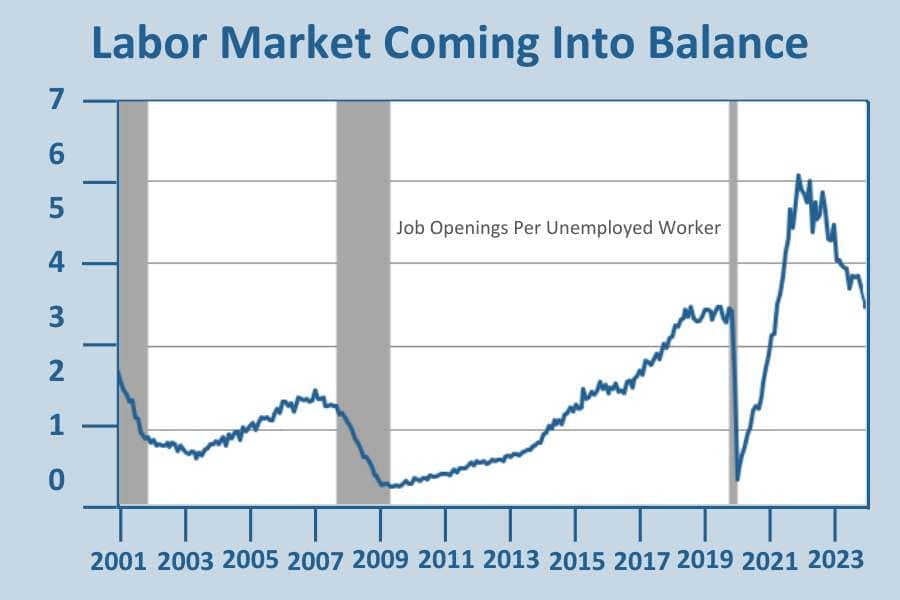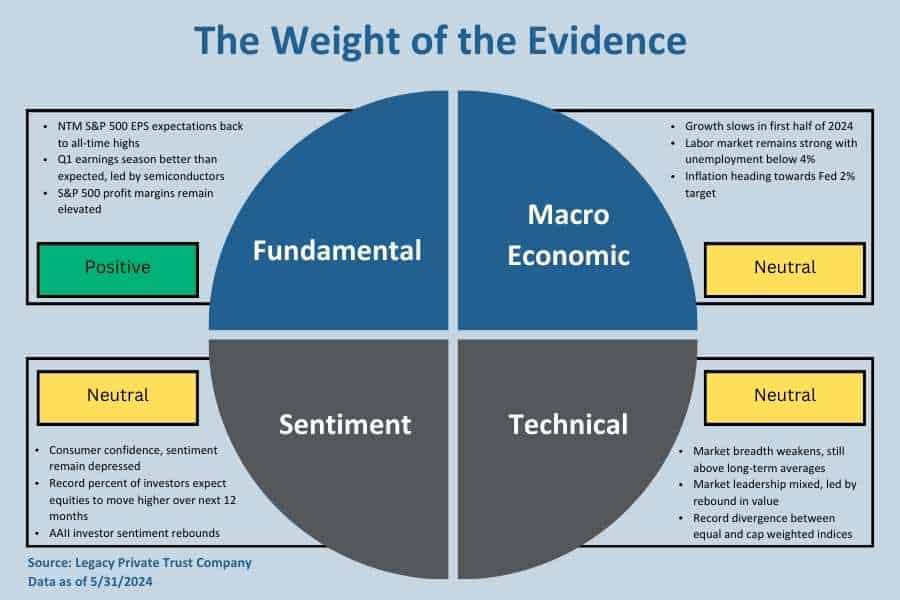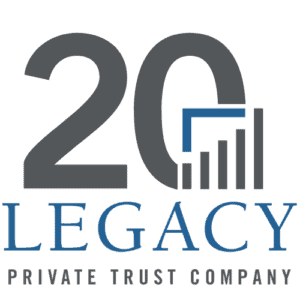It’s a long way to Christmas, but with a nod to that beloved holiday ballad, it’s beginning to look like a soft landing. Bing Crosby is no longer with us, but Federal Reserve Chair Jerome Powell may soon be singing the praises for the way the economy is performing. True, some parts are still getting in too hot, and inflation remains too high for the Fed to begin cutting rates. To no one’s surprise, they kept the target range on its federal funds rate at the current 5.25%-5.50% at the latest policy meeting in mid-June. But they also changed their forward guidance, expecting to reduce rates fewer times this year than they did back in March – one instead of three. Simply put, policymakers still believe the risk of easing up on the monetary brakes too soon outweighs the risk of waiting too long.
The central bank’s decision to keep rates higher for longer comes on the heels of softer-than-expected inflation reports and signs that the labor market is cooling – but not breaking. From the lens of investors, this combination indicates that conditions are ripe for an earlier rate cut than the Fed is signaling. Hence, the markets are pricing in a greater than 60% chance that the Fed will cut rates three times before the end of the year, putting a move as soon as July in play. It is not uncommon for the markets and the Fed to have different opinions on where rates should go. Such differences surfaced in each of the last three quarterly projections made by the Fed – in December, March, and now, June.
Significantly, earlier fears that the Fed may have to raise rates to curb stubborn inflation have fallen by the wayside. Those fears stemmed from a reacceleration of inflation in the first quarter that led some – including at least one Fed official – to believe that the current high interest rate level was insufficient to do the job. With two months of tame inflation reports now in hand, it looks like the earlier flareup was more of a speed bump than a derailment of the disinflation trend that prevailed in the second half of last year. The Fed, however, is not taking any chances and is waiting for more evidence that the current inflation retreat is sustainable. How many months of positive data they need remains to be seen. A wait-and-see strategy is appropriate as long as the economy holds up. However, the runway is getting shorter as the lagged effects of the Fed’s restrictive policy are about to cause deeper and broader damage to the economy. It may be time for the central bank to worry less about inflation and more about a possible recession.
Recession Signal
It’s been a while since worries about a pending recession were widespread. Early in the Fed’s rate-hiking cycle, there were deep concerns that the economy might be too fragile to withstand higher rates. After all, when the Fed began stepping on the monetary brakes in the spring of 2022 to stifle inflation, the harsh pandemic recession that threw 22 million workers out of jobs was still fresh in mind. What’s more, the nation had been conditioned to more than a decade of a near-zero interest rate policy (a.k.a. ZIRP), and it was unknown what impact the sudden shock of more expensive borrowing costs would have.
Indeed, the bond market rang the alarms shortly after the first rate hike in March 2022, pricing in a recession through the dreaded inverted yield curve, where yields on short-term notes are higher than on long-term bonds. That inverted relationship had reliably foreshadowed a recession within two years, so if the US escapes a downturn this time, it would be the loudest bond market false alarm ever. The curve has been inverted since June 2022, making this the longest stretch on record.
One reason it is a leading indicator of a recession is that it makes life miserable for banks, which borrow money in the short-term markets to finance longer-term loans – a losing proposition when short-term rates are higher than long-term rates. A brief banking crisis did erupt last spring, but government agencies quickly contained it and barely made a ripple in economic activity. It would be a mistake to dismiss the possibility that a recession is just around the bend. Based on its yield-curve model, the New York Fed still predicts a recession within the next 12 months.

Is This Time Different?
Of course, the usual refrain that “this time is different” rings loud and clear in the collective minds of economists. While it is easy to scoff at those who insist on defying history, there are reasons to agree with them this time. For one, the traditional forces that bring on a recession are either absent or are less potent than in the past. An external shock – such as an oil crisis or war – is a prime catalyst that has historically sent the economy into a downturn. Geopolitical tensions in Ukraine and Gaza might still become more of a negative catalyst if conditions worsen. But these events have been percolating for some time, and the surprise element that makes an external shock so potent would be defused.
For another, the impact of the Fed’s aggressive rate increases has been diluted by the ability of households and businesses to lock in low rates in the years prior to the rate-hiking campaign. Hence, a broad swath of borrowers are unaffected by the higher rates, and many actually fare better because the collateral behind the loans has appreciated in value. This is particularly true for most homeowners who are sitting on mortgages taken out at 3 – 4% during ZIRP for a home that has generated a huge equity cushion for owners since its purchase.
Finally, the economy is still benefiting from the fiscal tailwinds launched during the pandemic and its immediate aftermath, when Washington pumped trillions of dollars into business coffers and household bank accounts. The increased savings the stimulus payments provided to lower-income households have been used up. However, the economic boost from other legislation, such as the Inflation Reduction and Chips Acts, is still coursing through the economy. The Chips Act, in particular, is piggybacking on the AI revolution and supercharging the semiconductor industry, spurring the construction of new data centers and driving up demand for electrical equipment, such as switchers and transformers.
Cooling Job Market
However, despite the inverted yield curve, the biggest reason recession fears are muted this time is that the job market is not following the script that usually accompanies such a steep rise in interest rates. Typically, as the Fed tightens the screws, employers prepare for a drop in sales and revenues by restraining labor costs, starting with less hiring and soon, outright firings, sending the unemployment rate sharply higher. This sets in motion a self-reinforcing cycle wherein slowing wage growth and growing job insecurity lead to weaker consumption, which, in turn, feeds back and reinforces a deteriorating job market. The cycle ends with a recession, prompting the central bank to unwind the rate hikes that started the process.
That scenario was anticipated by the financial markets but not by the Fed. Fed officials believed they could avoid that historical endgame by guiding the economy into a soft landing –taming inflation without stoking a big increase in unemployment and, hence, a recession. The key to success, they believed, involved rebalancing a wildly unbalanced labor market that emerged from the pandemic when the demand for workers greatly exceeded the supply. Health concerns, a wave of retirements, and restrictive immigration during the early post-pandemic period reduced labor supply even as worker demand surged amid a stimulus-fueled spike in spending. By March 2022, there were more than two job openings for every unemployed worker.

But the white-hot job market has cooled considerably – just as the Fed wanted. Employers are curbing the demand for workers but not sending them to the unemployment lines. Meanwhile, workers – particularly women — have returned to the labor force as the health crisis eased; importantly, a surge in immigration has provided employers with newly arrived people taking many positions that Americans didn’t want. As a result, the gap between demand and supply for workers has mostly closed, as the ratio of job openings to unemployed workers is almost down to pre-pandemic levels.
Timing Is Key
As a result, one of the most feared inflation influences that is hard to contain without driving up unemployment – cost pressures from rising labor costs – is also cooling as wage growth is slowing. The problem in the eyes of the Fed is that it is not slowing fast enough and remains above the pace that is consistent with the Fed’s 2% inflation target. Wages are rising between 4-5% depending on which measure is used. To reach the 2% target with labor productivity increasing at a trend-like 1.5%, the Fed would like to see wage growth slow to 3.5%.
The question is, how much pain is the Fed willing to accept to achieve that target? The tailwinds that have kept the economy afloat throughout the rate-hiking cycle are losing momentum. Yes, homeowners have been insulated by the low mortgage rates obtained in earlier years. But that also adds to the strain in the housing market because these owners are staying put and keeping their homes off the market, which reinforces a chronic housing shortage and keeps upward pressure on home prices, shutting would-be buyers out of the market.
Meanwhile, the current high rate levels are punishing new borrowers, particularly lower-income households whose budgets are being squeezed by inflation and have had to rely more on credit cards to sustain purchases. Many are falling behind on debt repayments, and delinquency rates are climbing. They have not reached alarming levels yet, but banks are tightening lending standards on consumer loans. That combination of high debt burdens and less access to credit will, in time, put a crimp on personal consumption, the economy’s main growth driver.
Wealthier households account for about 80% of all consumer spending, and this cohort is still in good shape, thanks to healthy balance sheets that benefited from a strong stock market and increasing housing wealth. However, it is not easy to convert wealth into spendable funds, which comes mainly from current income. The incentive to hold more liquid savings increases as the job market softens, resulting in weaker spending. As noted, the cooling job market reflects mainly reduced hiring, not layoffs. However, claims for jobless benefits are creeping up; once that trend gains momentum, it is hard to stop, putting the Fed behind the curve and making it too late to avoid a recession. There is still time to monitor events. However, the runway is getting shorter, and takeoff for rate cuts should begin by the fall.

If you are a Legacy client and have questions, please do not hesitate to contact your Legacy advisor. If you are not a Legacy client and are interested in learning more about our approach to personalized wealth management, please contact us at 920.967.5020 or connect@lptrust.com.
The information contained herein is for informational purposes only and does not constitute a recommendation or advice. Any opinions are those of Legacy Private Trust Company only and represent our current analysis and judgment and are subject to change. Actual results, performance, or events may differ based on changing circumstances. No statements contained herein constitute any type of guarantee, nor are they a substitute for professional legal, tax, or other specialized advice.




